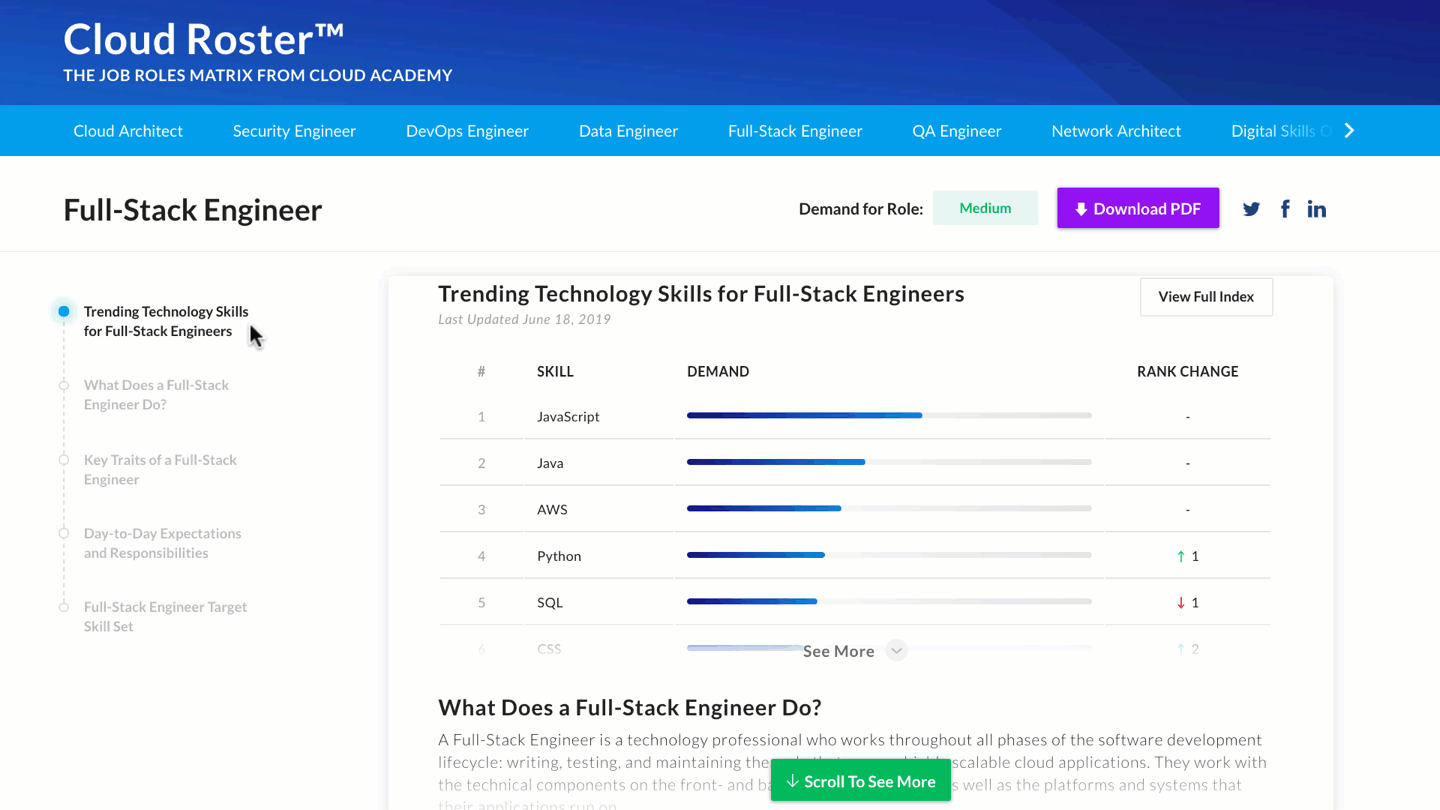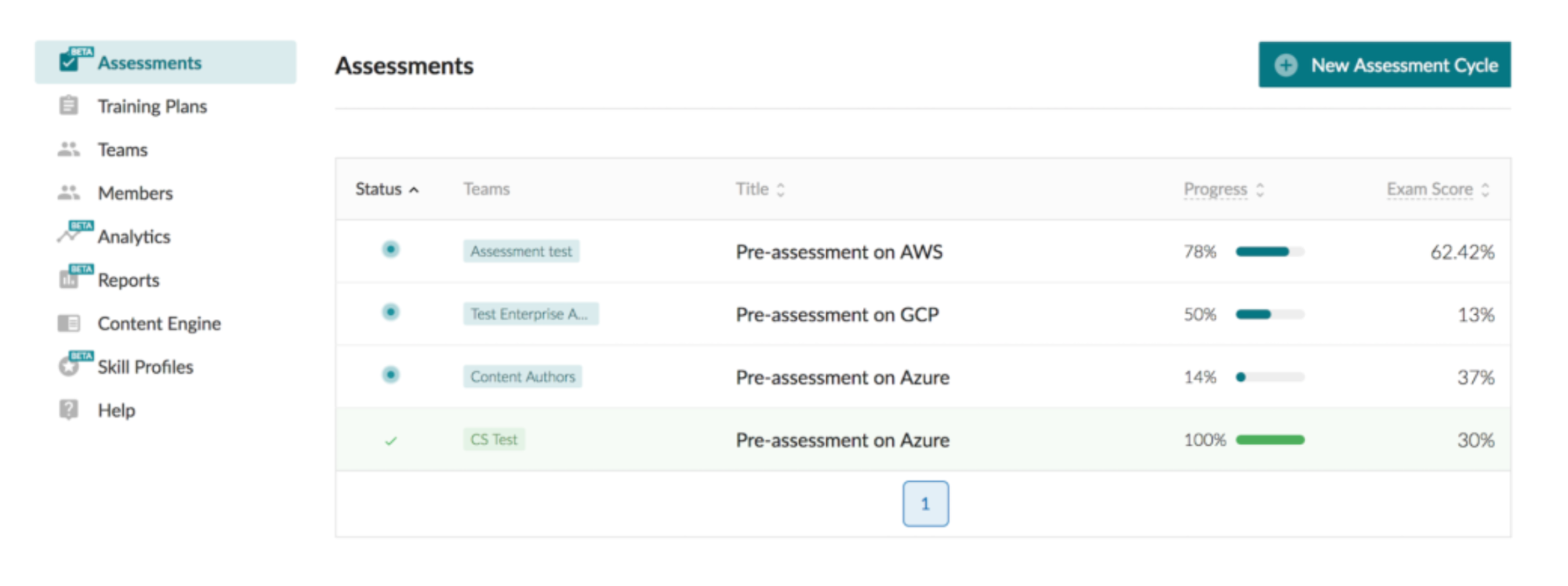A skilled team of IT talent is crucial for any business that wants to catch up to modern technology, develop software products, and implement a digital transformation. Hiring a full-stack developer that would not just fit the company’s corporate culture and system of values but would also be an outstanding professional is a challenge for Human Resource (HR) departments.
Hiring a full-stack developer is a complex process. And since there’s no one-size-fits-all approach to assessing the candidate’s resume, conducting a job interview, and making the final choice, it’s easy to start making mistakes from the get-go.
Without truly understanding the baseline skills, you’ll be at a disadvantage during the hiring process and may even hire an unqualified candidate. To learn the trending skills, roles and responsibilities, and industry-standard certifications, you’ll want to check out Cloud Roster™. It’s freely available and updated weekly.


What are the most important blunders companies make when filling remote IT jobs? What are the ways to efficiently assess a candidate’s skill without asking too much? Is remote work the future for software development talent? In this article, we’ll not only cover the mistakes, but we’ll also cover:
Mistakes in hiring a full-stack developer
When hiring, watch out for the following mistakes:
1. Unrealistic expectations
Especially common when hiring full-stack developers, the error lies in thinking a generalist has to be absolutely proficient on both the front-end and back-end level. If you want to hire a developer skilled in MongoBD, ExpressJS, AngularJS, and Node.js, consider hiring a mean stack development specialist instead of a full-stack one. Keep in mind, that a full-stack developer is more of a generalist — someone, who despite being 100% proficient in any field, is capable of covering many roles.
Hiring a full-stack developer makes absolute sense on the MVP development stage. There, you don’t need 100% reliable and bug-free code as much as a solution that works. When hiring, be ready to meet candidates who don’t have in-depth knowledge in certain areas of programming and don’t be taken back because of it. Instead, give candidates a chance to explain how they would manage the development process back-to-back, the roles they could covered, as well as their own vision on contributing to the company.
2. Ignoring technical tests
More often than not, when a hiring manager likes a candidate’s attitude towards the company and the candidate’s management and people skills, the manager hires the full-stack developer without thoroughly checking the candidate’s technical background. Thrown into a dynamic working environment, with dozens of tasks and not much time to start learning from scratch, such a candidate will struggle with delivery and underperform.
Having a team lead interview a potential hire from the technical standpoint is a way to solve the problem. It’s not ideal, as a lengthy interview process often exhausts candidates and there’s a chance to lose a potential fit to a company with a shorter hiring loop – still, it’s a risk-free approach for the company.
Another way to assess a candidate’s tech proficiency is by using dedicated tools, such as Cloud Academy’s Skill Assessment technology. It’s the fastest and most accurate way to assess and verify technical skills. Hiring managers can understand their talent portfolios by easily creating a technical assessment for full-stack developer candidates. The results process in real-time so that you can confidently onboard staff, identify subject matter experts, and define the next phase of your training strategy.


3. No face-to-face meetings
Ignoring face-to-face interviews is a common mistake for freelance full-stack developers and IT staffing services. Typically, an HR manager talks to a potential hire via email, messenger, or social media, takes a look at the resume and portfolio, and makes a decision.
While such an approach guarantees fast onboarding, face-to-face meetings (or camera-to-camera meetings with candidates for remote positions) help to create a deeper connection between the remote developer and the company. It also increases the feeling of responsibility and improves the candidate’s attitude.
Face-to-face interactions are a good way to show that you’re serious about hiring a quality candidate and ensures that the candidate is serious about the opportunity — be sure to not ignore it.
4. Underestimating the impact of portfolio
While professional staffing services often look at a candidate’s portfolio before scheduling an interview, many tend to not follow up on it during the interview. In fact, discussing work history is a quick way to see the candidate’s approach to development, strong points in development, presentation skills as well as the type of projects the candidate enjoys working on.
Discussing past projects is a major talking point during the interview that keeps both the candidate and the interviewer engaged in the process. Here are a few questions to ask a potential full-stack developer:
- What was your role on the project team?
- What did you learn after working on the projects?
- Which skills did the project involve?
- How much time did you spend working on the project?
5. Limiting the range of search
Finally, one of the biggest traps HR managers fall into is disregarding new destinations where to hire developers and sticking to traditional methods like job boards and college referrals. Using social media is a good way to expand the range of candidates beyond your referral tech talent pool. Here are a few ways to spread the word about the opening:
- Targeted ads across main communication channels
- Posting job openings on developer forums where there’s a higher probability to find job seekers
- Using platforms like AngelList
- Attending technical events to scout potential hires
Using the methods described above, you will not only be able to gain access to a wider range of remote candidates with lower salary requirement range, but you will spread awareness about the company as well.
Skills for interviewing full-stack developers
If you’re about to have a chat with a full-stack development candidate and want to optimize your insights about a potential employee, here are the skills you will need.
1. Stay in the loop with technology
Software development is one of the most rapidly changing industries in the world. As a good interviewer, you need to know which technologies are trending, the list of most popular programming languages used for back-end developers, and which third-party APIs are used for server management.
In order to build awareness about modern-day IT, keep an eye on StackOverflow surveys as well as technical editorials (TechRepublic, DZone, and so on). By staying in the loop, it’ll be easier for you to determine if a candidate has a drive for innovation.
2. Do research
Make it a goal to do some investigation before you interview the candidate. An HR manager who approaches research seriously will be able to ask the candidate the right questions and get a full view of the candidate’s profile.
Here are a few research destinations to background check full-stack developers:
- Repository. Run the candidate’s name through GitHub’s repository.
- References. Take the time to reach out to people listed as references to get a deeper look at the candidate’s approach and work attitude.
- Search. Run the candidate’s name through a Google Search query.
- Resume. Find data on the candidate’s involvement in projects that are stated in a resume, check the technology skills on resume, and the educational institution claimed on the resume, and so on. Catching fraud will save you a lot of time down the line as you will only interview reliable candidates.
3. Get to know the local IT market
Immersion into a local IT community is crucial for successful talent scouting. By simply following prominent talents from a competitor company, you’ll be able to be the first one to onboard good developers when they are open to new positions. Also, keeping track of what’s happening outside of your own microsystem will allow an HR recruiter to have a better idea of a candidate’s skill sets and experience, a project management methodology, and so on. Finally, you’ll be able to adopt smart practices of job description writing, interviewing, workflow management that worked out well for competitors.
Best practices for onboarding full-stack developers
When onboarding developers, keep in mind that not all HR practices will be equally effective. More often than not, onboarding orientation programs don’t turn out to be productive simply because introverted developers don’t feel comfortable participating.
For onboarding a full-stack developer, stick to the following practices:
- Cut down the number of meetings. Developers are rarely enthusiastic when it comes to discussing things out loud — some of them are not skilled in communication altogether. Also, scheduling meetings is a challenge for those wondering how to manage remote teams. Instead, outline a reporting system that would allow the management to track an employee’s progress without pushing the new hire out of the comfort zone.
- Outline expectations. Developer should clearly see the objectives they are working toward, including deadlines and KPIs. This way, they’ll be able to plan time efficiently and see the bigger picture of their work.
- Be open to requests and communicate it. As developers spend a lot of time in their workplaces, be sure to make it comfortable. During onboarding, collect feedback on how the developers would like their desks to look. Try to adhere to these requests to the best extent possible unless they put a strain on the company’s budget.
- Encourage peer-to-peer mentoring. Both in-house and remote employees perceive the workplace as a space for learning through peer socialization, and a company should facilitate a comfortable learning environment. Instead of adopting a vertical management system — with a clear mentor-subordinate paradigm — encourage all developers to share knowledge with others. To support this goal, you can even create dedicated networking events.
Conclusion
Hiring a full-stack developer for in-house, remote, or offshore software development is challenging due to the wide range of responsibilities the role entails. The good news is that by following the trends in the IT market, taking time to get to know the candidate on a personal and professional level, and accumulating knowledge on working with remote teams, an HR recruiter should be able to find a fit in no time.
Remember that in case you still haven’t found a fit, it might have to do with overbearing expectation. Keep an open mind and take time to assess candidates who don’t strike you as prominent at first glance — an engaging project and a learning-friendly environment will help your new hires find their groove.



